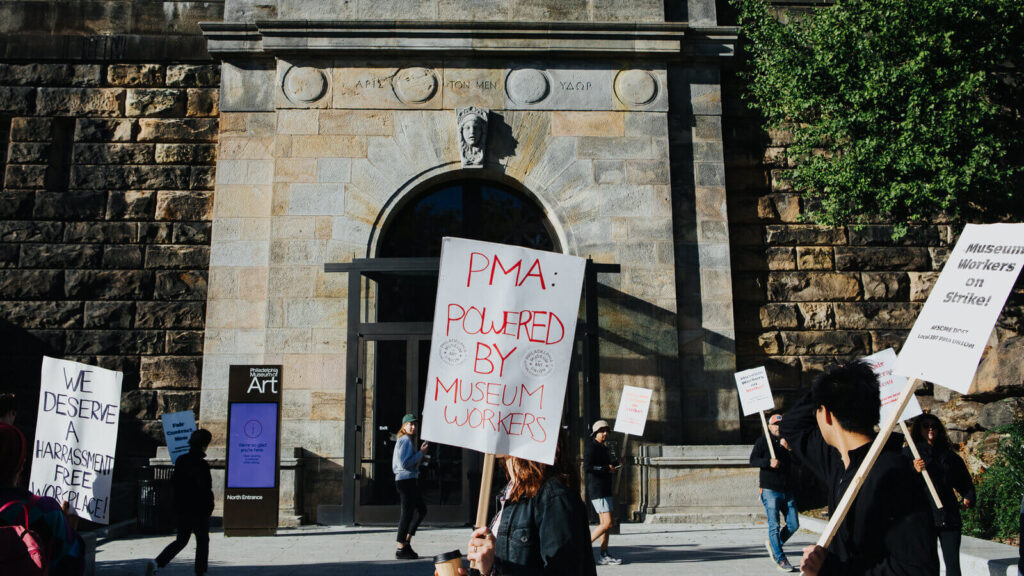Milla Manheim ’25
On October 22, the 19-day strike of unionized workers at the Philadelphia Museum of Art (PMA) came to a stop, bringing two years’ worth of negotiations to a close. The strike coincided with the Matisse: in the 1930s art exhibition, and as a result, the museum made the controversial decision to rely on temporary non-union workers to open the exhibit. Despite coming to an agreement, there are still lingering feelings of resentment between PMA administrators and employees.
PMA workers started the strike on September 26 to force the museum to conclude the past two years of contract negotiations. According to The Art Newspaper, many workers felt indignation because the museum administrators ignored the contract agreements about their pay and benefits. After two weeks of protests, they reached a consensus, and the contract was ratified with a 99% majority vote of the PMA members. Starting on July 1, 2023, the museum workers’ healthcare plans cost will be reduced, their wage will increase by 14% over the life of the contract, and their minimum wage has been raised to $16.75 an hour.

Photo courtesy of nytimes.com
Anika Kakarla ’23 comments, “It’s great to see that the PMA workers protested to get better pay. I think that it is important for workers to fight for their rights after COVID with many workers being overworked and mistreated.”
The strike at the PMA is an example of the collective cries of workers around the US for fair compensation and protest of stalled contracts. Robert Maier, Upper School AP Art History Teacher, explains, “There’s been a big wave of labor-organizing activity at a lot of the leading museums in the country, like the Whitney in New York and the Massachusetts Museum of Contemporary Art… and this strike will probably accelerate that trend that had already been starting.”
David Sigel, Upper School Art Department Chair, adds that the strike is “more about employee vs. employer and causes no friction in how people see art.” However, the strike still holds an impact on the art world as the employees and the art community are interconnected. Offering insight from past experience, Sigel comments, “A lot of museum workers are artists themselves.”
While the strike brought together some parts of the community, it also created “bad blood” between some institutions and individuals. Sigel says, “It caused tension between the two factions of workers at PMA; the art workers vs administrators.” He also believes the tension was inevitable, saying, “Anytime you deal with people’s livelihoods, and feelings of right and wrong there’s going to be tension.”

Photo courtesy of artforum.com
During the strike the PMA faced scrutiny through social media. Maier recalls that “there was a point during the strike when the museum disabled comments on social media.” Much of the backlash the museum faced was due to the hiring of outsiders to install the priceless Matisse exhibition as their professional workers were on strike.
Even after coming to an agreement, many of the workers held grudges against the museum board. Program manager Nicole Cooke expressed her distaste to The Arts Newspaper, explaining that when the art was “hung by untested scabs (people who cross the picket line to replace striking workers) and high-level managers who have not done this work regularly in years, if ever, all of us in the union were horrified.”
However, the museum was cornered into a situation with no other opportunity than to hire outsiders. As a result, it is almost impossible to find, as Sigel puts it, “a balance of fairness to employees and fairness to visitors.” Maier also explains, “It goes both ways because in order to have the money to pay the workers, the museum needs to have these big shows like The Matisse show… and the gala opening would not have happened if they hadn’t hired other people to hang the show.”As of now, all the workers have returned to their jobs and the contractual agreements are settled. While on the surface things seem to be resolved, there are still underlying feelings of animosity. Maier explains why some union workers continue to feel undermined by the museum: by hiring others, the PMA “showed that they didn’t value the art handlers that they had already on staff.” Per The Art Newspaper, the PMA is successfully hosting The Matisse show until January 30th, and, despite residual conflicts, the new contract indicates a brighter future for the workers at the museum.